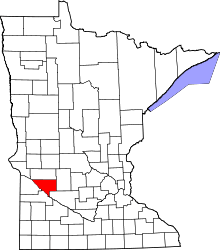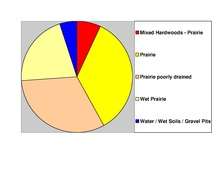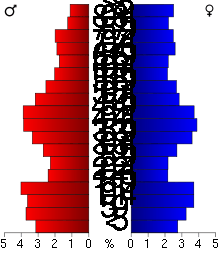Chippewa County, Minnesota
| Chippewa County, Minnesota | |
|---|---|
 Location in the U.S. state of Minnesota | |
 Minnesota's location in the U.S. | |
| Founded |
February 20, 1862 (created) 1868 (organized)[1] |
| Named for | Chippewa River[2] |
| Seat | Montevideo |
| Largest city | Montevideo |
| Area | |
| • Total | 588 sq mi (1,523 km2) |
| • Land | 581 sq mi (1,505 km2) |
| • Water | 6.7 sq mi (17 km2), 1.1% |
| Population (est.) | |
| • (2015) | 12,109 |
| • Density | 21/sq mi (8/km²) |
| Congressional district | 7th |
| Time zone | Central: UTC-6/-5 |
| Website |
www |
Chippewa County is a county located in the U.S. state of Minnesota. As of the 2010 census, the population was 12,441.[3] Its county seat is Montevideo.[4] The county was formed in 1862 and organized in 1868.
Geography
According to the U.S. Census Bureau, the county has a total area of 588 square miles (1,520 km2), of which 581 square miles (1,500 km2) is land and 6.7 square miles (17 km2) (1.1%) is water.[5]

Lakes
- Carlton Lake: in Sparta Township
- Norboro Lake: in Stoneham Township
- Shakopee Lake: in Grace Township
Major highways
 U.S. Highway 59
U.S. Highway 59.svg.png) U.S. Highway 212
U.S. Highway 212  Minnesota State Highway 7
Minnesota State Highway 7 Minnesota State Highway 23
Minnesota State Highway 23 Minnesota State Highway 29
Minnesota State Highway 29 Minnesota State Highway 40
Minnesota State Highway 40 Minnesota State Highway 277
Minnesota State Highway 277
Adjacent counties
- Swift County (north)
- Kandiyohi County (northeast)
- Renville County (southeast)
- Yellow Medicine County (southwest)
- Lac qui Parle County (west)
Climate and weather
| Montevideo, Minnesota | ||||||||||||||||||||||||||||||||||||||||||||||||||||||||||||
|---|---|---|---|---|---|---|---|---|---|---|---|---|---|---|---|---|---|---|---|---|---|---|---|---|---|---|---|---|---|---|---|---|---|---|---|---|---|---|---|---|---|---|---|---|---|---|---|---|---|---|---|---|---|---|---|---|---|---|---|---|
| Climate chart (explanation) | ||||||||||||||||||||||||||||||||||||||||||||||||||||||||||||
| ||||||||||||||||||||||||||||||||||||||||||||||||||||||||||||
| ||||||||||||||||||||||||||||||||||||||||||||||||||||||||||||
In recent years, average temperatures in the county seat of Montevideo have ranged from a low of 2 °F (−17 °C) in January to a high of 83 °F (28 °C) in July, although a record low of −37 °F (−38 °C) was recorded in January 1970 and a record high of 110 °F (43 °C) was recorded in July 1988. Average monthly precipitation ranged from 0.86 inches (22 mm) in December to 4.24 inches (108 mm) in June.[7]
Demographics
| Historical population | |||
|---|---|---|---|
| Census | Pop. | %± | |
| 1870 | 1,467 | — | |
| 1880 | 5,408 | 268.6% | |
| 1890 | 8,555 | 58.2% | |
| 1900 | 12,499 | 46.1% | |
| 1910 | 13,458 | 7.7% | |
| 1920 | 15,720 | 16.8% | |
| 1930 | 15,762 | 0.3% | |
| 1940 | 16,927 | 7.4% | |
| 1950 | 16,739 | −1.1% | |
| 1960 | 16,320 | −2.5% | |
| 1970 | 15,109 | −7.4% | |
| 1980 | 14,941 | −1.1% | |
| 1990 | 13,228 | −11.5% | |
| 2000 | 13,088 | −1.1% | |
| 2010 | 12,441 | −4.9% | |
| Est. 2015 | 12,109 | [8] | −2.7% |
| U.S. Decennial Census[9] 1790-1960[10] 1900-1990[11] 1990-2000[12] 2010-2015[3] | |||

As of the census of 2000,[13] there were 13,088 people, 5,361 households, and 3,597 families residing in the county. The population density was 22 people per square mile (9/km²). There were 5,855 housing units at an average density of 10 per square mile (4/km²). The racial makeup of the county was 96.78% White, 0.18% Black or African American, 1.00% Native American, 0.30% Asian, 0.02% Pacific Islander, 0.94% from other races, and 0.79% from two or more races. 1.92% of the population were Hispanic or Latino of any race. 37.8% were of Norwegian and 36.8% German ancestry.
There were 5,361 households, out of which 31.20% had children under the age of 18 living with them, 57.00% were married couples living together, 6.60% had a female householder with no husband present, and 32.90% were non-families. 29.50% of all households were made up of individuals and 15.70% had someone living alone who was 65 years of age or older. The average household size was 2.39 and the average family size was 2.96.
In the county the population was spread out with 25.40% under the age of 18, 7.10% from 18 to 24, 24.50% from 25 to 44, 23.00% from 45 to 64, and 20.00% who were 65 years of age or older. The median age was 40 years. For every 100 females there were 94.80 males. For every 100 females age 18 and over, there were 91.30 males.
The median income for a household in the county was $35,582, and the median income for a family was $45,160. Males had a median income of $30,556 versus $20,384 for females. The per capita income for the county was $18,039. About 4.80% of families and 8.60% of the population were below the poverty line, including 9.80% of those under age 18 and 9.30% of those age 65 or over.
Communities
Cities
- Clara City
- Granite Falls (partial)
- Maynard
- Milan
- Montevideo (county seat)
- Watson
Townships
See also
References
- ↑ "Minnesota Place Names". Minnesota Historical Society. Retrieved March 17, 2014.
- ↑ Upham, Warren (1920). Minnesota Geographic Names: Their Origin and Historic Significance. Minnesota Historical Society. p. 102.
- 1 2 "State & County QuickFacts". United States Census Bureau. Retrieved August 31, 2013.
- ↑ "Find a County". National Association of Counties. Archived from the original on 2015-05-10. Retrieved 2011-06-07.
- ↑ "2010 Census Gazetteer Files". United States Census Bureau. August 22, 2012. Archived from the original on October 6, 2014. Retrieved October 6, 2014.
- ↑ Nelson, Steven (2011). Savanna Soils of Minnesota. Minnesota: Self. pp. 65 - 67. ISBN 978-0-615-50320-2.
- 1 2 "Monthly Averages for Montevideo, Minnesota". The Weather Channel. Retrieved 2011-11-06.
- ↑ "County Totals Dataset: Population, Population Change and Estimated Components of Population Change: April 1, 2010 to July 1, 2015". Retrieved July 2, 2016.
- ↑ "U.S. Decennial Census". United States Census Bureau. Archived from the original on May 11, 2015. Retrieved October 6, 2014.
- ↑ "Historical Census Browser". University of Virginia Library. Retrieved October 6, 2014.
- ↑ "Population of Counties by Decennial Census: 1900 to 1990". United States Census Bureau. Retrieved October 6, 2014.
- ↑ "Census 2000 PHC-T-4. Ranking Tables for Counties: 1990 and 2000" (PDF). United States Census Bureau. Retrieved October 6, 2014.
- ↑ "American FactFinder". United States Census Bureau. Archived from the original on 2013-09-11. Retrieved 2008-01-31.
External links
 |
Swift County | Kandiyohi County |  | |
| Lac qui Parle County | |
|||
| ||||
| | ||||
| Yellow Medicine County | Renville County |
Coordinates: 45°02′N 95°34′W / 45.03°N 95.56°W